Sustainable Tourism: Ljubljana Destination Analysis Report
VerifiedAdded on 2023/01/11
|13
|4202
|56
Report
AI Summary
This report delves into the realm of sustainable and responsible tourism management, examining its evolution and core principles. It explores the role of global organizations like the UNWTO in promoting ethical tourism practices and analyzes the processes of tourism development and planning, particularly in the context of Ljubljana, Slovenia. The report investigates the economic, social, cultural, and environmental impacts of tourism activities, evaluating how sustainability principles are implemented and managed. It assesses stakeholder involvement and offers recommendations for improving sustainable tourism management in tourist destinations, providing a comprehensive analysis of the challenges and opportunities in the field. The report also discusses the role of sustainable tourism in Ljubljana, its economic impacts, social impacts, and environmental impacts. The report provides a detailed analysis of how to achieve the success in sustainable development. It provides insights on how to analyze the various things which helps in having proper use of the natural resource and maintain the proper balance among the given resource.
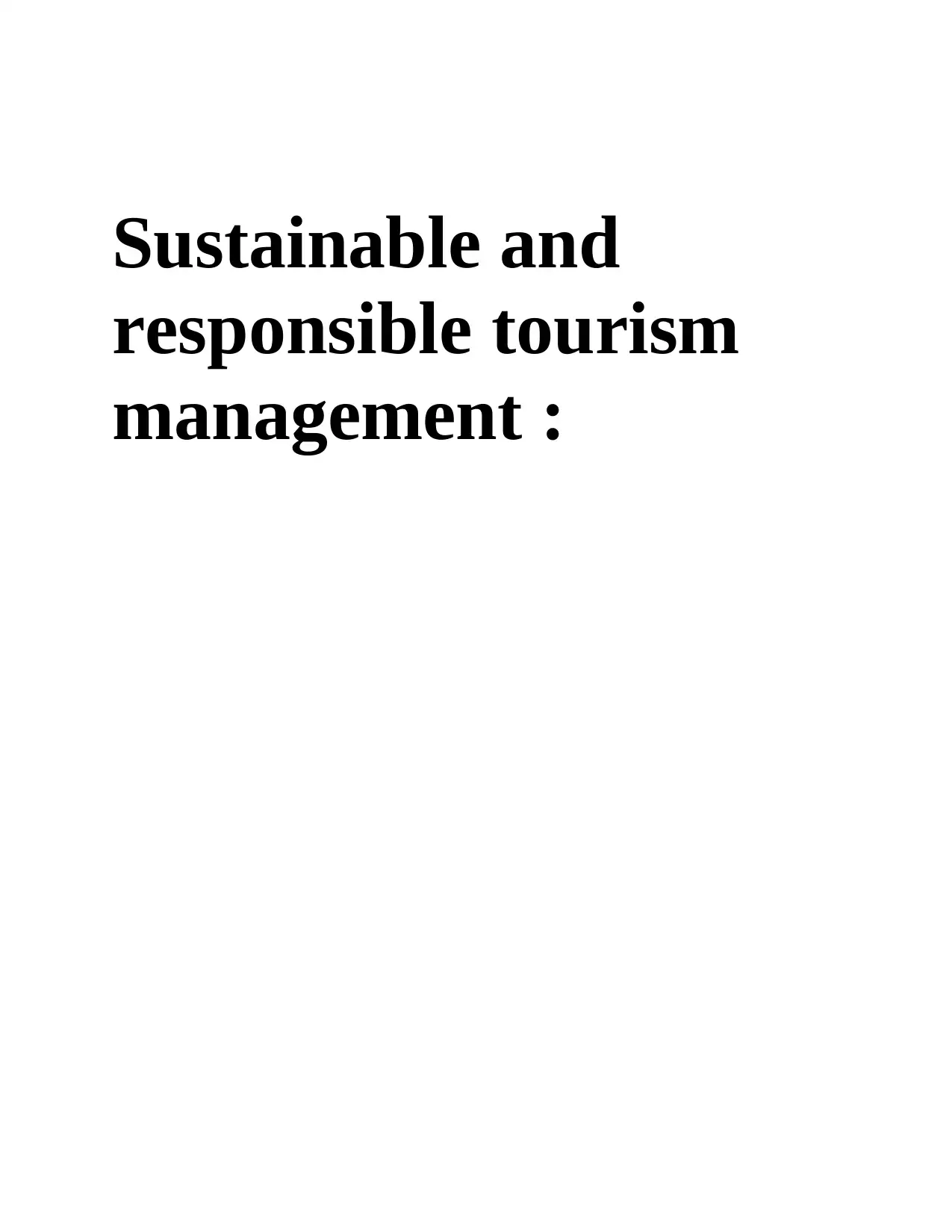
Sustainable and
responsible tourism
management :
responsible tourism
management :
Paraphrase This Document
Need a fresh take? Get an instant paraphrase of this document with our AI Paraphraser
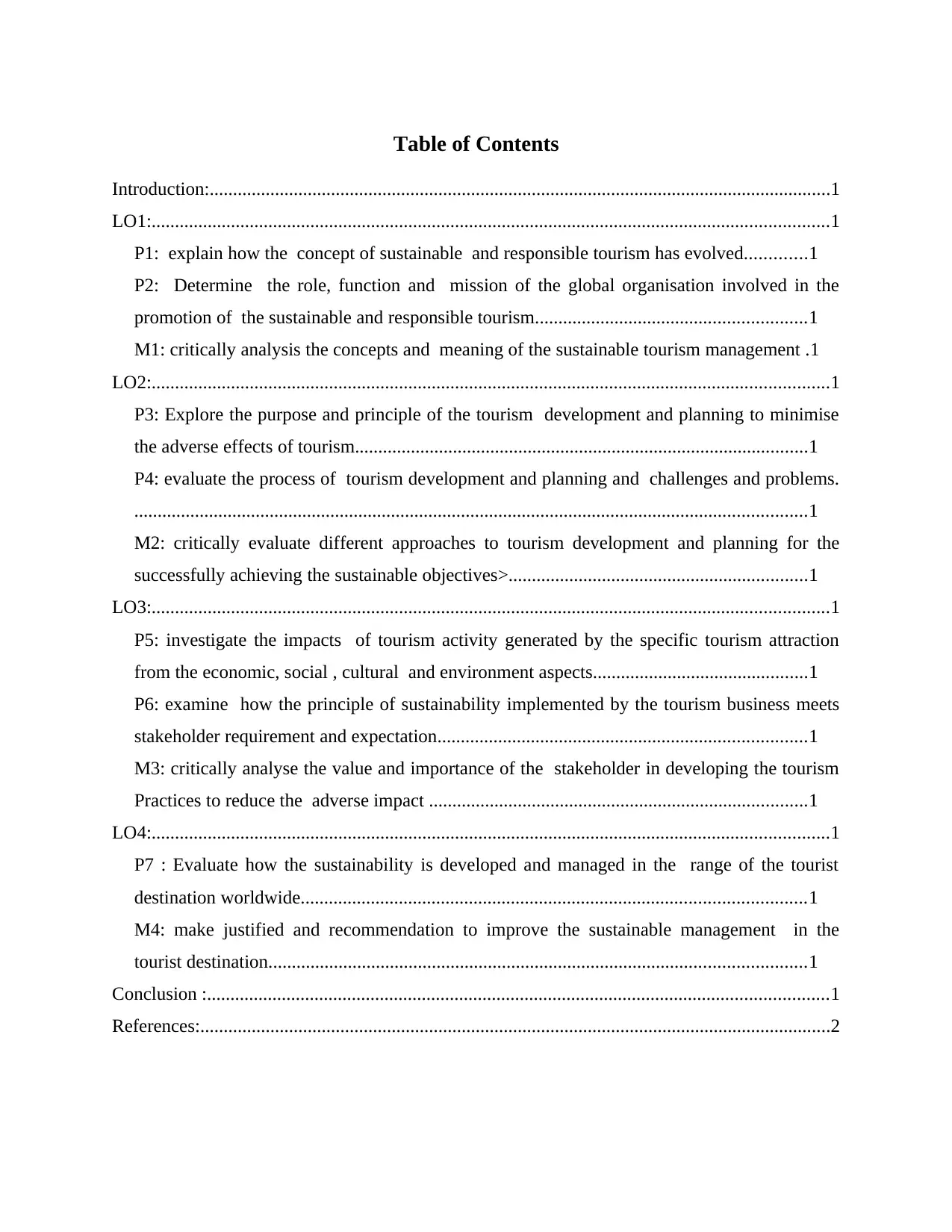
Table of Contents
Introduction:.....................................................................................................................................1
LO1:.................................................................................................................................................1
P1: explain how the concept of sustainable and responsible tourism has evolved.............1
P2: Determine the role, function and mission of the global organisation involved in the
promotion of the sustainable and responsible tourism..........................................................1
M1: critically analysis the concepts and meaning of the sustainable tourism management .1
LO2:.................................................................................................................................................1
P3: Explore the purpose and principle of the tourism development and planning to minimise
the adverse effects of tourism.................................................................................................1
P4: evaluate the process of tourism development and planning and challenges and problems.
................................................................................................................................................1
M2: critically evaluate different approaches to tourism development and planning for the
successfully achieving the sustainable objectives>................................................................1
LO3:.................................................................................................................................................1
P5: investigate the impacts of tourism activity generated by the specific tourism attraction
from the economic, social , cultural and environment aspects..............................................1
P6: examine how the principle of sustainability implemented by the tourism business meets
stakeholder requirement and expectation...............................................................................1
M3: critically analyse the value and importance of the stakeholder in developing the tourism
Practices to reduce the adverse impact .................................................................................1
LO4:.................................................................................................................................................1
P7 : Evaluate how the sustainability is developed and managed in the range of the tourist
destination worldwide............................................................................................................1
M4: make justified and recommendation to improve the sustainable management in the
tourist destination...................................................................................................................1
Conclusion :.....................................................................................................................................1
References:.......................................................................................................................................2
Introduction:.....................................................................................................................................1
LO1:.................................................................................................................................................1
P1: explain how the concept of sustainable and responsible tourism has evolved.............1
P2: Determine the role, function and mission of the global organisation involved in the
promotion of the sustainable and responsible tourism..........................................................1
M1: critically analysis the concepts and meaning of the sustainable tourism management .1
LO2:.................................................................................................................................................1
P3: Explore the purpose and principle of the tourism development and planning to minimise
the adverse effects of tourism.................................................................................................1
P4: evaluate the process of tourism development and planning and challenges and problems.
................................................................................................................................................1
M2: critically evaluate different approaches to tourism development and planning for the
successfully achieving the sustainable objectives>................................................................1
LO3:.................................................................................................................................................1
P5: investigate the impacts of tourism activity generated by the specific tourism attraction
from the economic, social , cultural and environment aspects..............................................1
P6: examine how the principle of sustainability implemented by the tourism business meets
stakeholder requirement and expectation...............................................................................1
M3: critically analyse the value and importance of the stakeholder in developing the tourism
Practices to reduce the adverse impact .................................................................................1
LO4:.................................................................................................................................................1
P7 : Evaluate how the sustainability is developed and managed in the range of the tourist
destination worldwide............................................................................................................1
M4: make justified and recommendation to improve the sustainable management in the
tourist destination...................................................................................................................1
Conclusion :.....................................................................................................................................1
References:.......................................................................................................................................2
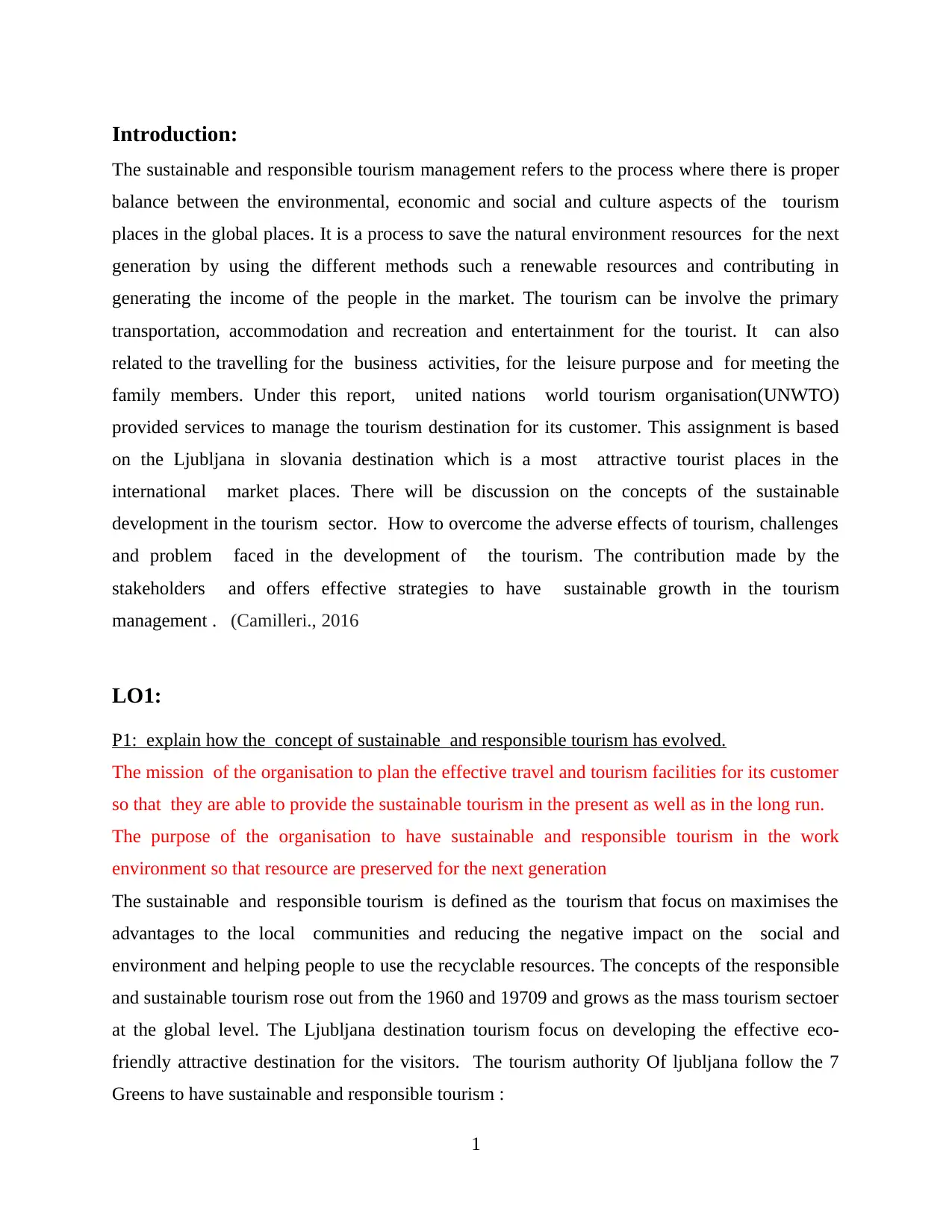
Introduction:
The sustainable and responsible tourism management refers to the process where there is proper
balance between the environmental, economic and social and culture aspects of the tourism
places in the global places. It is a process to save the natural environment resources for the next
generation by using the different methods such a renewable resources and contributing in
generating the income of the people in the market. The tourism can be involve the primary
transportation, accommodation and recreation and entertainment for the tourist. It can also
related to the travelling for the business activities, for the leisure purpose and for meeting the
family members. Under this report, united nations world tourism organisation(UNWTO)
provided services to manage the tourism destination for its customer. This assignment is based
on the Ljubljana in slovania destination which is a most attractive tourist places in the
international market places. There will be discussion on the concepts of the sustainable
development in the tourism sector. How to overcome the adverse effects of tourism, challenges
and problem faced in the development of the tourism. The contribution made by the
stakeholders and offers effective strategies to have sustainable growth in the tourism
management . (Camilleri., 2016
LO1:
P1: explain how the concept of sustainable and responsible tourism has evolved.
The mission of the organisation to plan the effective travel and tourism facilities for its customer
so that they are able to provide the sustainable tourism in the present as well as in the long run.
The purpose of the organisation to have sustainable and responsible tourism in the work
environment so that resource are preserved for the next generation
The sustainable and responsible tourism is defined as the tourism that focus on maximises the
advantages to the local communities and reducing the negative impact on the social and
environment and helping people to use the recyclable resources. The concepts of the responsible
and sustainable tourism rose out from the 1960 and 19709 and grows as the mass tourism sectoer
at the global level. The Ljubljana destination tourism focus on developing the effective eco-
friendly attractive destination for the visitors. The tourism authority Of ljubljana follow the 7
Greens to have sustainable and responsible tourism :
1
The sustainable and responsible tourism management refers to the process where there is proper
balance between the environmental, economic and social and culture aspects of the tourism
places in the global places. It is a process to save the natural environment resources for the next
generation by using the different methods such a renewable resources and contributing in
generating the income of the people in the market. The tourism can be involve the primary
transportation, accommodation and recreation and entertainment for the tourist. It can also
related to the travelling for the business activities, for the leisure purpose and for meeting the
family members. Under this report, united nations world tourism organisation(UNWTO)
provided services to manage the tourism destination for its customer. This assignment is based
on the Ljubljana in slovania destination which is a most attractive tourist places in the
international market places. There will be discussion on the concepts of the sustainable
development in the tourism sector. How to overcome the adverse effects of tourism, challenges
and problem faced in the development of the tourism. The contribution made by the
stakeholders and offers effective strategies to have sustainable growth in the tourism
management . (Camilleri., 2016
LO1:
P1: explain how the concept of sustainable and responsible tourism has evolved.
The mission of the organisation to plan the effective travel and tourism facilities for its customer
so that they are able to provide the sustainable tourism in the present as well as in the long run.
The purpose of the organisation to have sustainable and responsible tourism in the work
environment so that resource are preserved for the next generation
The sustainable and responsible tourism is defined as the tourism that focus on maximises the
advantages to the local communities and reducing the negative impact on the social and
environment and helping people to use the recyclable resources. The concepts of the responsible
and sustainable tourism rose out from the 1960 and 19709 and grows as the mass tourism sectoer
at the global level. The Ljubljana destination tourism focus on developing the effective eco-
friendly attractive destination for the visitors. The tourism authority Of ljubljana follow the 7
Greens to have sustainable and responsible tourism :
1
⊘ This is a preview!⊘
Do you want full access?
Subscribe today to unlock all pages.

Trusted by 1+ million students worldwide
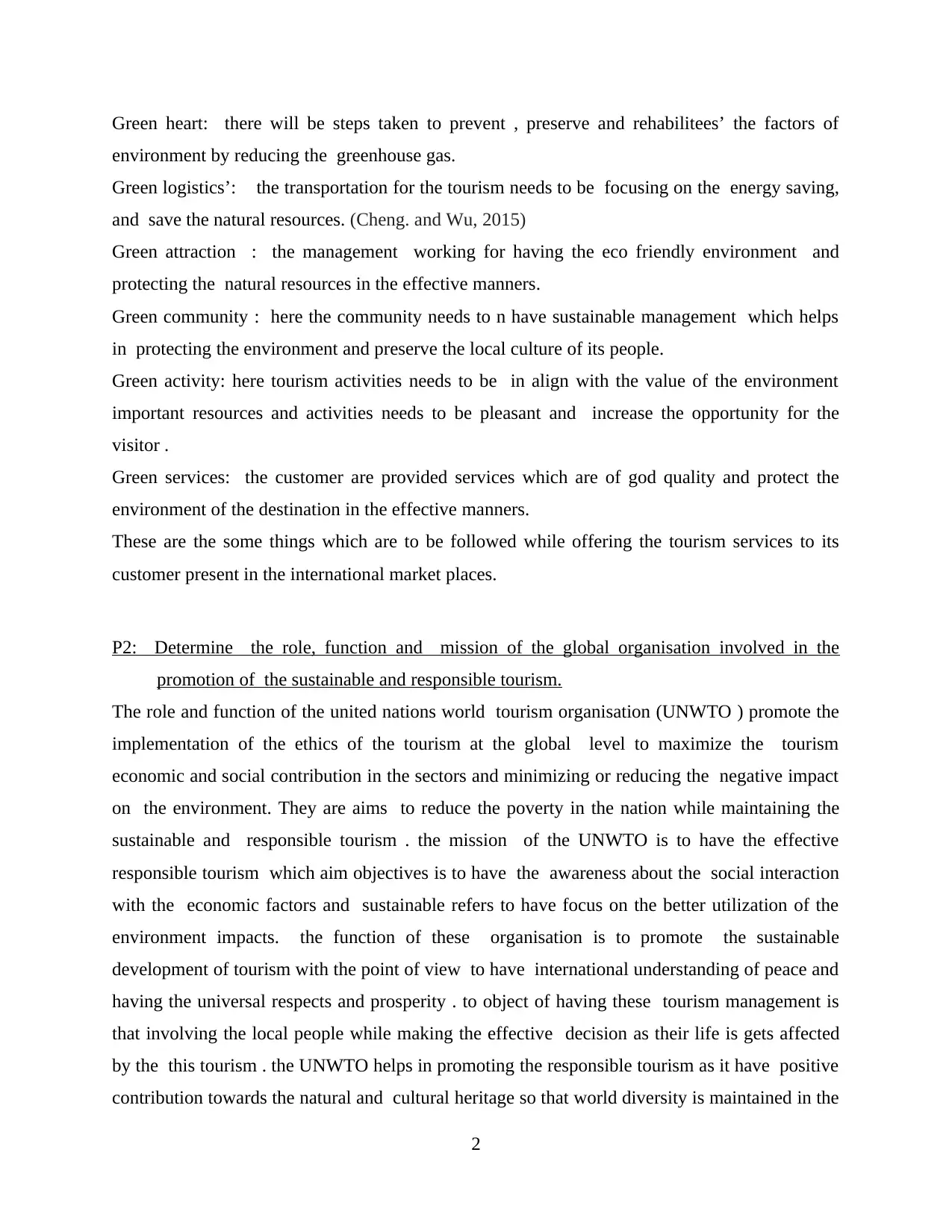
Green heart: there will be steps taken to prevent , preserve and rehabilitees’ the factors of
environment by reducing the greenhouse gas.
Green logistics’: the transportation for the tourism needs to be focusing on the energy saving,
and save the natural resources. (Cheng. and Wu, 2015)
Green attraction : the management working for having the eco friendly environment and
protecting the natural resources in the effective manners.
Green community : here the community needs to n have sustainable management which helps
in protecting the environment and preserve the local culture of its people.
Green activity: here tourism activities needs to be in align with the value of the environment
important resources and activities needs to be pleasant and increase the opportunity for the
visitor .
Green services: the customer are provided services which are of god quality and protect the
environment of the destination in the effective manners.
These are the some things which are to be followed while offering the tourism services to its
customer present in the international market places.
P2: Determine the role, function and mission of the global organisation involved in the
promotion of the sustainable and responsible tourism.
The role and function of the united nations world tourism organisation (UNWTO ) promote the
implementation of the ethics of the tourism at the global level to maximize the tourism
economic and social contribution in the sectors and minimizing or reducing the negative impact
on the environment. They are aims to reduce the poverty in the nation while maintaining the
sustainable and responsible tourism . the mission of the UNWTO is to have the effective
responsible tourism which aim objectives is to have the awareness about the social interaction
with the economic factors and sustainable refers to have focus on the better utilization of the
environment impacts. the function of these organisation is to promote the sustainable
development of tourism with the point of view to have international understanding of peace and
having the universal respects and prosperity . to object of having these tourism management is
that involving the local people while making the effective decision as their life is gets affected
by the this tourism . the UNWTO helps in promoting the responsible tourism as it have positive
contribution towards the natural and cultural heritage so that world diversity is maintained in the
2
environment by reducing the greenhouse gas.
Green logistics’: the transportation for the tourism needs to be focusing on the energy saving,
and save the natural resources. (Cheng. and Wu, 2015)
Green attraction : the management working for having the eco friendly environment and
protecting the natural resources in the effective manners.
Green community : here the community needs to n have sustainable management which helps
in protecting the environment and preserve the local culture of its people.
Green activity: here tourism activities needs to be in align with the value of the environment
important resources and activities needs to be pleasant and increase the opportunity for the
visitor .
Green services: the customer are provided services which are of god quality and protect the
environment of the destination in the effective manners.
These are the some things which are to be followed while offering the tourism services to its
customer present in the international market places.
P2: Determine the role, function and mission of the global organisation involved in the
promotion of the sustainable and responsible tourism.
The role and function of the united nations world tourism organisation (UNWTO ) promote the
implementation of the ethics of the tourism at the global level to maximize the tourism
economic and social contribution in the sectors and minimizing or reducing the negative impact
on the environment. They are aims to reduce the poverty in the nation while maintaining the
sustainable and responsible tourism . the mission of the UNWTO is to have the effective
responsible tourism which aim objectives is to have the awareness about the social interaction
with the economic factors and sustainable refers to have focus on the better utilization of the
environment impacts. the function of these organisation is to promote the sustainable
development of tourism with the point of view to have international understanding of peace and
having the universal respects and prosperity . to object of having these tourism management is
that involving the local people while making the effective decision as their life is gets affected
by the this tourism . the UNWTO helps in promoting the responsible tourism as it have positive
contribution towards the natural and cultural heritage so that world diversity is maintained in the
2
Paraphrase This Document
Need a fresh take? Get an instant paraphrase of this document with our AI Paraphraser
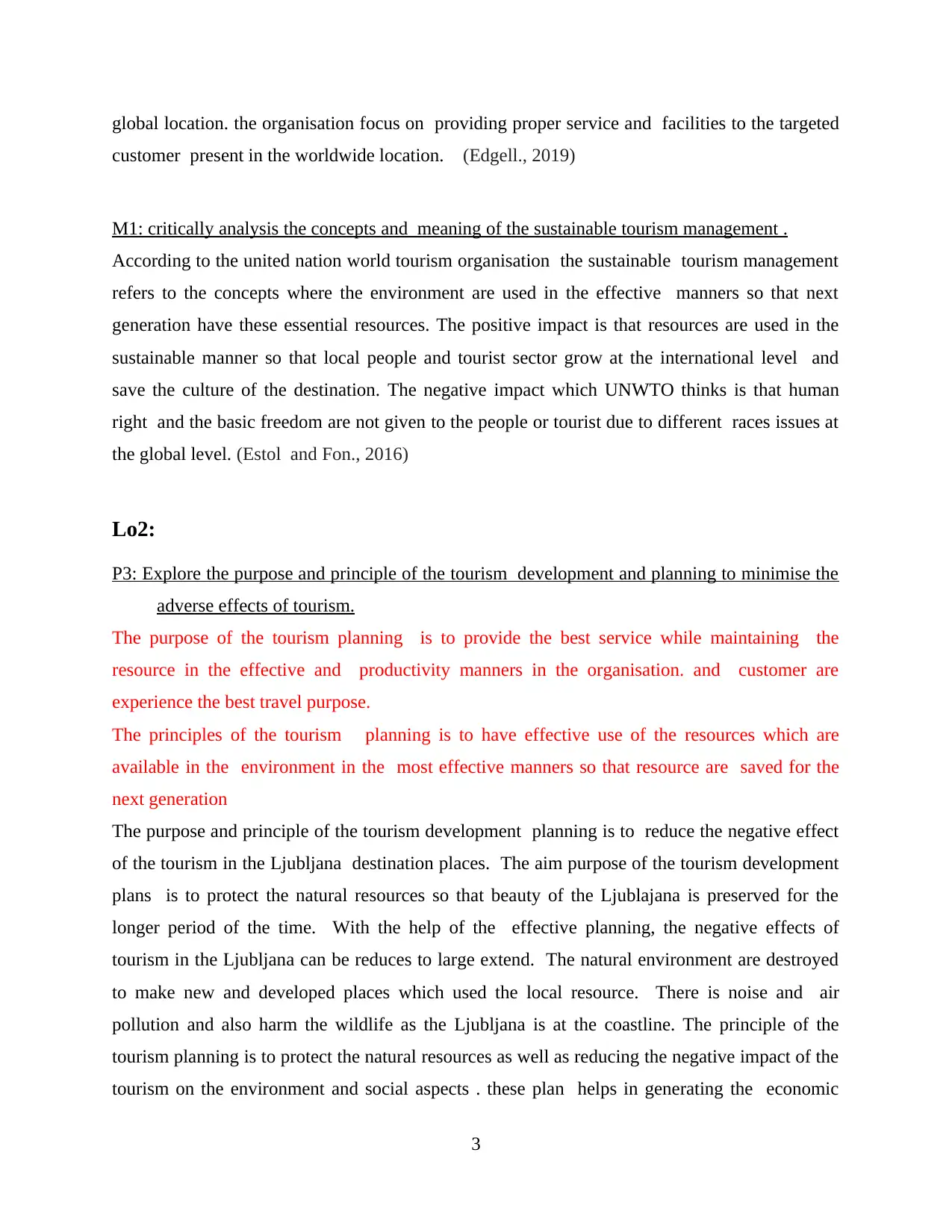
global location. the organisation focus on providing proper service and facilities to the targeted
customer present in the worldwide location. (Edgell., 2019)
M1: critically analysis the concepts and meaning of the sustainable tourism management .
According to the united nation world tourism organisation the sustainable tourism management
refers to the concepts where the environment are used in the effective manners so that next
generation have these essential resources. The positive impact is that resources are used in the
sustainable manner so that local people and tourist sector grow at the international level and
save the culture of the destination. The negative impact which UNWTO thinks is that human
right and the basic freedom are not given to the people or tourist due to different races issues at
the global level. (Estol and Fon., 2016)
Lo2:
P3: Explore the purpose and principle of the tourism development and planning to minimise the
adverse effects of tourism.
The purpose of the tourism planning is to provide the best service while maintaining the
resource in the effective and productivity manners in the organisation. and customer are
experience the best travel purpose.
The principles of the tourism planning is to have effective use of the resources which are
available in the environment in the most effective manners so that resource are saved for the
next generation
The purpose and principle of the tourism development planning is to reduce the negative effect
of the tourism in the Ljubljana destination places. The aim purpose of the tourism development
plans is to protect the natural resources so that beauty of the Ljublajana is preserved for the
longer period of the time. With the help of the effective planning, the negative effects of
tourism in the Ljubljana can be reduces to large extend. The natural environment are destroyed
to make new and developed places which used the local resource. There is noise and air
pollution and also harm the wildlife as the Ljubljana is at the coastline. The principle of the
tourism planning is to protect the natural resources as well as reducing the negative impact of the
tourism on the environment and social aspects . these plan helps in generating the economic
3
customer present in the worldwide location. (Edgell., 2019)
M1: critically analysis the concepts and meaning of the sustainable tourism management .
According to the united nation world tourism organisation the sustainable tourism management
refers to the concepts where the environment are used in the effective manners so that next
generation have these essential resources. The positive impact is that resources are used in the
sustainable manner so that local people and tourist sector grow at the international level and
save the culture of the destination. The negative impact which UNWTO thinks is that human
right and the basic freedom are not given to the people or tourist due to different races issues at
the global level. (Estol and Fon., 2016)
Lo2:
P3: Explore the purpose and principle of the tourism development and planning to minimise the
adverse effects of tourism.
The purpose of the tourism planning is to provide the best service while maintaining the
resource in the effective and productivity manners in the organisation. and customer are
experience the best travel purpose.
The principles of the tourism planning is to have effective use of the resources which are
available in the environment in the most effective manners so that resource are saved for the
next generation
The purpose and principle of the tourism development planning is to reduce the negative effect
of the tourism in the Ljubljana destination places. The aim purpose of the tourism development
plans is to protect the natural resources so that beauty of the Ljublajana is preserved for the
longer period of the time. With the help of the effective planning, the negative effects of
tourism in the Ljubljana can be reduces to large extend. The natural environment are destroyed
to make new and developed places which used the local resource. There is noise and air
pollution and also harm the wildlife as the Ljubljana is at the coastline. The principle of the
tourism planning is to protect the natural resources as well as reducing the negative impact of the
tourism on the environment and social aspects . these plan helps in generating the economic
3
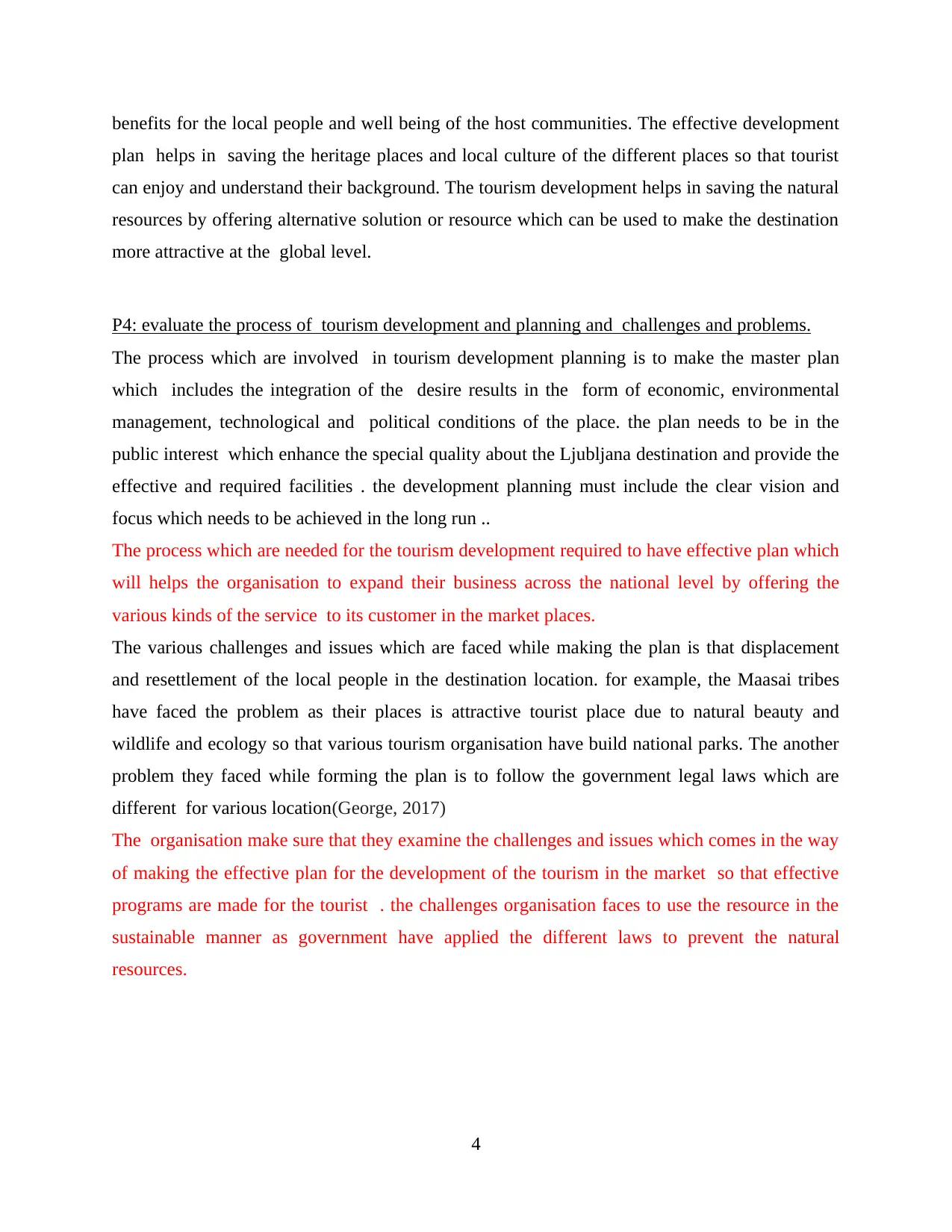
benefits for the local people and well being of the host communities. The effective development
plan helps in saving the heritage places and local culture of the different places so that tourist
can enjoy and understand their background. The tourism development helps in saving the natural
resources by offering alternative solution or resource which can be used to make the destination
more attractive at the global level.
P4: evaluate the process of tourism development and planning and challenges and problems.
The process which are involved in tourism development planning is to make the master plan
which includes the integration of the desire results in the form of economic, environmental
management, technological and political conditions of the place. the plan needs to be in the
public interest which enhance the special quality about the Ljubljana destination and provide the
effective and required facilities . the development planning must include the clear vision and
focus which needs to be achieved in the long run ..
The process which are needed for the tourism development required to have effective plan which
will helps the organisation to expand their business across the national level by offering the
various kinds of the service to its customer in the market places.
The various challenges and issues which are faced while making the plan is that displacement
and resettlement of the local people in the destination location. for example, the Maasai tribes
have faced the problem as their places is attractive tourist place due to natural beauty and
wildlife and ecology so that various tourism organisation have build national parks. The another
problem they faced while forming the plan is to follow the government legal laws which are
different for various location(George, 2017)
The organisation make sure that they examine the challenges and issues which comes in the way
of making the effective plan for the development of the tourism in the market so that effective
programs are made for the tourist . the challenges organisation faces to use the resource in the
sustainable manner as government have applied the different laws to prevent the natural
resources.
4
plan helps in saving the heritage places and local culture of the different places so that tourist
can enjoy and understand their background. The tourism development helps in saving the natural
resources by offering alternative solution or resource which can be used to make the destination
more attractive at the global level.
P4: evaluate the process of tourism development and planning and challenges and problems.
The process which are involved in tourism development planning is to make the master plan
which includes the integration of the desire results in the form of economic, environmental
management, technological and political conditions of the place. the plan needs to be in the
public interest which enhance the special quality about the Ljubljana destination and provide the
effective and required facilities . the development planning must include the clear vision and
focus which needs to be achieved in the long run ..
The process which are needed for the tourism development required to have effective plan which
will helps the organisation to expand their business across the national level by offering the
various kinds of the service to its customer in the market places.
The various challenges and issues which are faced while making the plan is that displacement
and resettlement of the local people in the destination location. for example, the Maasai tribes
have faced the problem as their places is attractive tourist place due to natural beauty and
wildlife and ecology so that various tourism organisation have build national parks. The another
problem they faced while forming the plan is to follow the government legal laws which are
different for various location(George, 2017)
The organisation make sure that they examine the challenges and issues which comes in the way
of making the effective plan for the development of the tourism in the market so that effective
programs are made for the tourist . the challenges organisation faces to use the resource in the
sustainable manner as government have applied the different laws to prevent the natural
resources.
4
⊘ This is a preview!⊘
Do you want full access?
Subscribe today to unlock all pages.

Trusted by 1+ million students worldwide
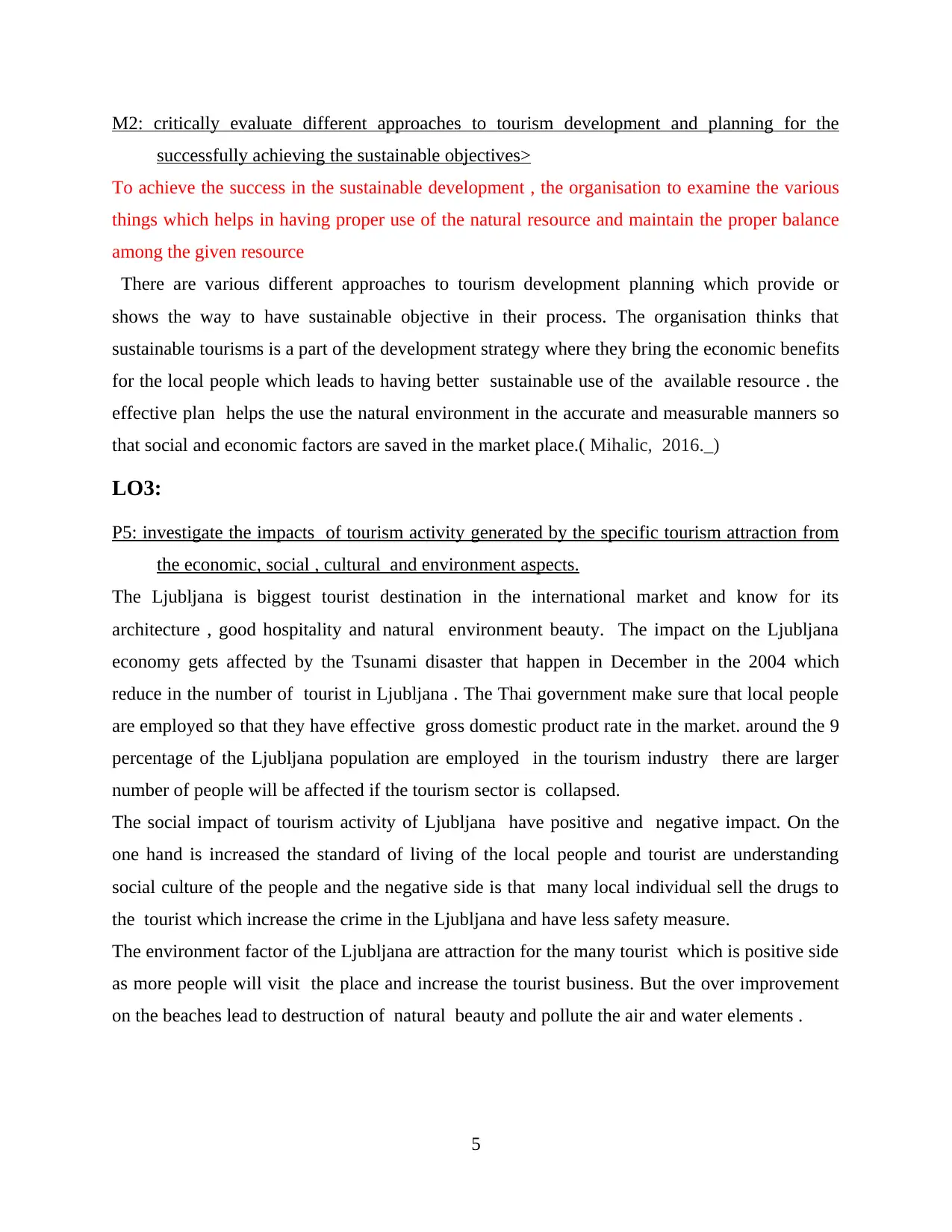
M2: critically evaluate different approaches to tourism development and planning for the
successfully achieving the sustainable objectives>
To achieve the success in the sustainable development , the organisation to examine the various
things which helps in having proper use of the natural resource and maintain the proper balance
among the given resource
There are various different approaches to tourism development planning which provide or
shows the way to have sustainable objective in their process. The organisation thinks that
sustainable tourisms is a part of the development strategy where they bring the economic benefits
for the local people which leads to having better sustainable use of the available resource . the
effective plan helps the use the natural environment in the accurate and measurable manners so
that social and economic factors are saved in the market place.( Mihalic, 2016._)
LO3:
P5: investigate the impacts of tourism activity generated by the specific tourism attraction from
the economic, social , cultural and environment aspects.
The Ljubljana is biggest tourist destination in the international market and know for its
architecture , good hospitality and natural environment beauty. The impact on the Ljubljana
economy gets affected by the Tsunami disaster that happen in December in the 2004 which
reduce in the number of tourist in Ljubljana . The Thai government make sure that local people
are employed so that they have effective gross domestic product rate in the market. around the 9
percentage of the Ljubljana population are employed in the tourism industry there are larger
number of people will be affected if the tourism sector is collapsed.
The social impact of tourism activity of Ljubljana have positive and negative impact. On the
one hand is increased the standard of living of the local people and tourist are understanding
social culture of the people and the negative side is that many local individual sell the drugs to
the tourist which increase the crime in the Ljubljana and have less safety measure.
The environment factor of the Ljubljana are attraction for the many tourist which is positive side
as more people will visit the place and increase the tourist business. But the over improvement
on the beaches lead to destruction of natural beauty and pollute the air and water elements .
5
successfully achieving the sustainable objectives>
To achieve the success in the sustainable development , the organisation to examine the various
things which helps in having proper use of the natural resource and maintain the proper balance
among the given resource
There are various different approaches to tourism development planning which provide or
shows the way to have sustainable objective in their process. The organisation thinks that
sustainable tourisms is a part of the development strategy where they bring the economic benefits
for the local people which leads to having better sustainable use of the available resource . the
effective plan helps the use the natural environment in the accurate and measurable manners so
that social and economic factors are saved in the market place.( Mihalic, 2016._)
LO3:
P5: investigate the impacts of tourism activity generated by the specific tourism attraction from
the economic, social , cultural and environment aspects.
The Ljubljana is biggest tourist destination in the international market and know for its
architecture , good hospitality and natural environment beauty. The impact on the Ljubljana
economy gets affected by the Tsunami disaster that happen in December in the 2004 which
reduce in the number of tourist in Ljubljana . The Thai government make sure that local people
are employed so that they have effective gross domestic product rate in the market. around the 9
percentage of the Ljubljana population are employed in the tourism industry there are larger
number of people will be affected if the tourism sector is collapsed.
The social impact of tourism activity of Ljubljana have positive and negative impact. On the
one hand is increased the standard of living of the local people and tourist are understanding
social culture of the people and the negative side is that many local individual sell the drugs to
the tourist which increase the crime in the Ljubljana and have less safety measure.
The environment factor of the Ljubljana are attraction for the many tourist which is positive side
as more people will visit the place and increase the tourist business. But the over improvement
on the beaches lead to destruction of natural beauty and pollute the air and water elements .
5
Paraphrase This Document
Need a fresh take? Get an instant paraphrase of this document with our AI Paraphraser
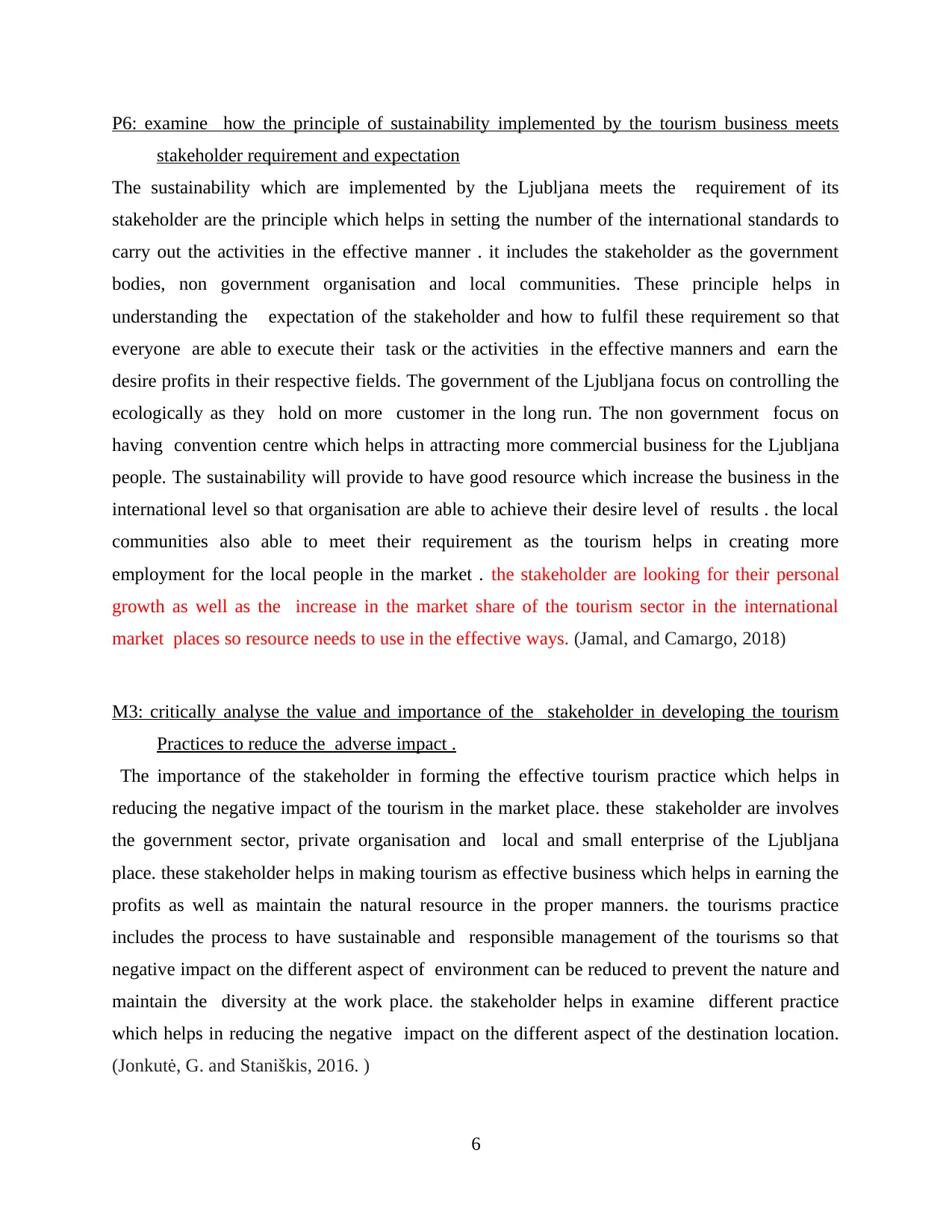
P6: examine how the principle of sustainability implemented by the tourism business meets
stakeholder requirement and expectation
The sustainability which are implemented by the Ljubljana meets the requirement of its
stakeholder are the principle which helps in setting the number of the international standards to
carry out the activities in the effective manner . it includes the stakeholder as the government
bodies, non government organisation and local communities. These principle helps in
understanding the expectation of the stakeholder and how to fulfil these requirement so that
everyone are able to execute their task or the activities in the effective manners and earn the
desire profits in their respective fields. The government of the Ljubljana focus on controlling the
ecologically as they hold on more customer in the long run. The non government focus on
having convention centre which helps in attracting more commercial business for the Ljubljana
people. The sustainability will provide to have good resource which increase the business in the
international level so that organisation are able to achieve their desire level of results . the local
communities also able to meet their requirement as the tourism helps in creating more
employment for the local people in the market . the stakeholder are looking for their personal
growth as well as the increase in the market share of the tourism sector in the international
market places so resource needs to use in the effective ways. (Jamal, and Camargo, 2018)
M3: critically analyse the value and importance of the stakeholder in developing the tourism
Practices to reduce the adverse impact .
The importance of the stakeholder in forming the effective tourism practice which helps in
reducing the negative impact of the tourism in the market place. these stakeholder are involves
the government sector, private organisation and local and small enterprise of the Ljubljana
place. these stakeholder helps in making tourism as effective business which helps in earning the
profits as well as maintain the natural resource in the proper manners. the tourisms practice
includes the process to have sustainable and responsible management of the tourisms so that
negative impact on the different aspect of environment can be reduced to prevent the nature and
maintain the diversity at the work place. the stakeholder helps in examine different practice
which helps in reducing the negative impact on the different aspect of the destination location.
(Jonkutė, G. and Staniškis, 2016. )
6
stakeholder requirement and expectation
The sustainability which are implemented by the Ljubljana meets the requirement of its
stakeholder are the principle which helps in setting the number of the international standards to
carry out the activities in the effective manner . it includes the stakeholder as the government
bodies, non government organisation and local communities. These principle helps in
understanding the expectation of the stakeholder and how to fulfil these requirement so that
everyone are able to execute their task or the activities in the effective manners and earn the
desire profits in their respective fields. The government of the Ljubljana focus on controlling the
ecologically as they hold on more customer in the long run. The non government focus on
having convention centre which helps in attracting more commercial business for the Ljubljana
people. The sustainability will provide to have good resource which increase the business in the
international level so that organisation are able to achieve their desire level of results . the local
communities also able to meet their requirement as the tourism helps in creating more
employment for the local people in the market . the stakeholder are looking for their personal
growth as well as the increase in the market share of the tourism sector in the international
market places so resource needs to use in the effective ways. (Jamal, and Camargo, 2018)
M3: critically analyse the value and importance of the stakeholder in developing the tourism
Practices to reduce the adverse impact .
The importance of the stakeholder in forming the effective tourism practice which helps in
reducing the negative impact of the tourism in the market place. these stakeholder are involves
the government sector, private organisation and local and small enterprise of the Ljubljana
place. these stakeholder helps in making tourism as effective business which helps in earning the
profits as well as maintain the natural resource in the proper manners. the tourisms practice
includes the process to have sustainable and responsible management of the tourisms so that
negative impact on the different aspect of environment can be reduced to prevent the nature and
maintain the diversity at the work place. the stakeholder helps in examine different practice
which helps in reducing the negative impact on the different aspect of the destination location.
(Jonkutė, G. and Staniškis, 2016. )
6
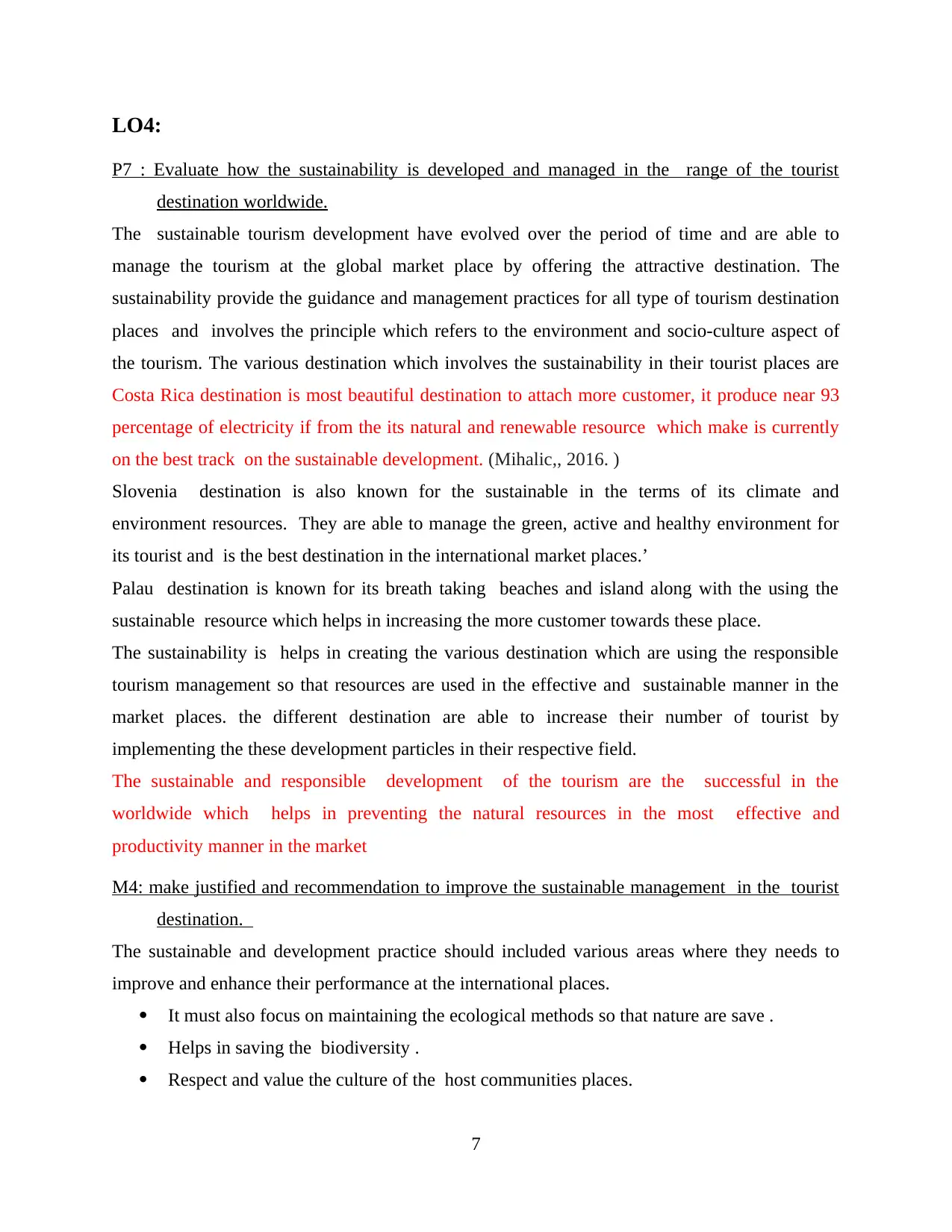
LO4:
P7 : Evaluate how the sustainability is developed and managed in the range of the tourist
destination worldwide.
The sustainable tourism development have evolved over the period of time and are able to
manage the tourism at the global market place by offering the attractive destination. The
sustainability provide the guidance and management practices for all type of tourism destination
places and involves the principle which refers to the environment and socio-culture aspect of
the tourism. The various destination which involves the sustainability in their tourist places are
Costa Rica destination is most beautiful destination to attach more customer, it produce near 93
percentage of electricity if from the its natural and renewable resource which make is currently
on the best track on the sustainable development. (Mihalic,, 2016. )
Slovenia destination is also known for the sustainable in the terms of its climate and
environment resources. They are able to manage the green, active and healthy environment for
its tourist and is the best destination in the international market places.’
Palau destination is known for its breath taking beaches and island along with the using the
sustainable resource which helps in increasing the more customer towards these place.
The sustainability is helps in creating the various destination which are using the responsible
tourism management so that resources are used in the effective and sustainable manner in the
market places. the different destination are able to increase their number of tourist by
implementing the these development particles in their respective field.
The sustainable and responsible development of the tourism are the successful in the
worldwide which helps in preventing the natural resources in the most effective and
productivity manner in the market
M4: make justified and recommendation to improve the sustainable management in the tourist
destination.
The sustainable and development practice should included various areas where they needs to
improve and enhance their performance at the international places.
It must also focus on maintaining the ecological methods so that nature are save .
Helps in saving the biodiversity .
Respect and value the culture of the host communities places.
7
P7 : Evaluate how the sustainability is developed and managed in the range of the tourist
destination worldwide.
The sustainable tourism development have evolved over the period of time and are able to
manage the tourism at the global market place by offering the attractive destination. The
sustainability provide the guidance and management practices for all type of tourism destination
places and involves the principle which refers to the environment and socio-culture aspect of
the tourism. The various destination which involves the sustainability in their tourist places are
Costa Rica destination is most beautiful destination to attach more customer, it produce near 93
percentage of electricity if from the its natural and renewable resource which make is currently
on the best track on the sustainable development. (Mihalic,, 2016. )
Slovenia destination is also known for the sustainable in the terms of its climate and
environment resources. They are able to manage the green, active and healthy environment for
its tourist and is the best destination in the international market places.’
Palau destination is known for its breath taking beaches and island along with the using the
sustainable resource which helps in increasing the more customer towards these place.
The sustainability is helps in creating the various destination which are using the responsible
tourism management so that resources are used in the effective and sustainable manner in the
market places. the different destination are able to increase their number of tourist by
implementing the these development particles in their respective field.
The sustainable and responsible development of the tourism are the successful in the
worldwide which helps in preventing the natural resources in the most effective and
productivity manner in the market
M4: make justified and recommendation to improve the sustainable management in the tourist
destination.
The sustainable and development practice should included various areas where they needs to
improve and enhance their performance at the international places.
It must also focus on maintaining the ecological methods so that nature are save .
Helps in saving the biodiversity .
Respect and value the culture of the host communities places.
7
⊘ This is a preview!⊘
Do you want full access?
Subscribe today to unlock all pages.

Trusted by 1+ million students worldwide
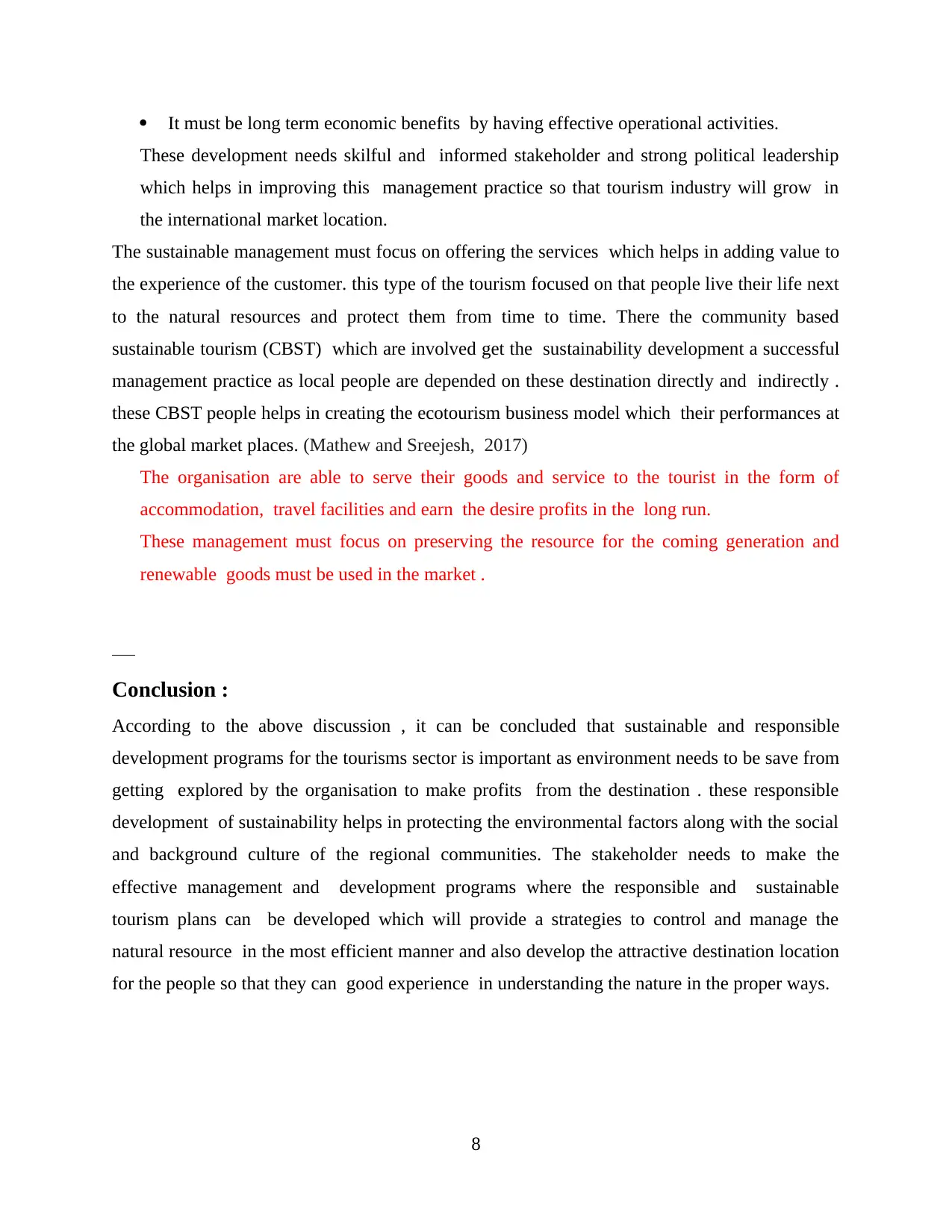
It must be long term economic benefits by having effective operational activities.
These development needs skilful and informed stakeholder and strong political leadership
which helps in improving this management practice so that tourism industry will grow in
the international market location.
The sustainable management must focus on offering the services which helps in adding value to
the experience of the customer. this type of the tourism focused on that people live their life next
to the natural resources and protect them from time to time. There the community based
sustainable tourism (CBST) which are involved get the sustainability development a successful
management practice as local people are depended on these destination directly and indirectly .
these CBST people helps in creating the ecotourism business model which their performances at
the global market places. (Mathew and Sreejesh, 2017)
The organisation are able to serve their goods and service to the tourist in the form of
accommodation, travel facilities and earn the desire profits in the long run.
These management must focus on preserving the resource for the coming generation and
renewable goods must be used in the market .
Conclusion :
According to the above discussion , it can be concluded that sustainable and responsible
development programs for the tourisms sector is important as environment needs to be save from
getting explored by the organisation to make profits from the destination . these responsible
development of sustainability helps in protecting the environmental factors along with the social
and background culture of the regional communities. The stakeholder needs to make the
effective management and development programs where the responsible and sustainable
tourism plans can be developed which will provide a strategies to control and manage the
natural resource in the most efficient manner and also develop the attractive destination location
for the people so that they can good experience in understanding the nature in the proper ways.
8
These development needs skilful and informed stakeholder and strong political leadership
which helps in improving this management practice so that tourism industry will grow in
the international market location.
The sustainable management must focus on offering the services which helps in adding value to
the experience of the customer. this type of the tourism focused on that people live their life next
to the natural resources and protect them from time to time. There the community based
sustainable tourism (CBST) which are involved get the sustainability development a successful
management practice as local people are depended on these destination directly and indirectly .
these CBST people helps in creating the ecotourism business model which their performances at
the global market places. (Mathew and Sreejesh, 2017)
The organisation are able to serve their goods and service to the tourist in the form of
accommodation, travel facilities and earn the desire profits in the long run.
These management must focus on preserving the resource for the coming generation and
renewable goods must be used in the market .
Conclusion :
According to the above discussion , it can be concluded that sustainable and responsible
development programs for the tourisms sector is important as environment needs to be save from
getting explored by the organisation to make profits from the destination . these responsible
development of sustainability helps in protecting the environmental factors along with the social
and background culture of the regional communities. The stakeholder needs to make the
effective management and development programs where the responsible and sustainable
tourism plans can be developed which will provide a strategies to control and manage the
natural resource in the most efficient manner and also develop the attractive destination location
for the people so that they can good experience in understanding the nature in the proper ways.
8
Paraphrase This Document
Need a fresh take? Get an instant paraphrase of this document with our AI Paraphraser
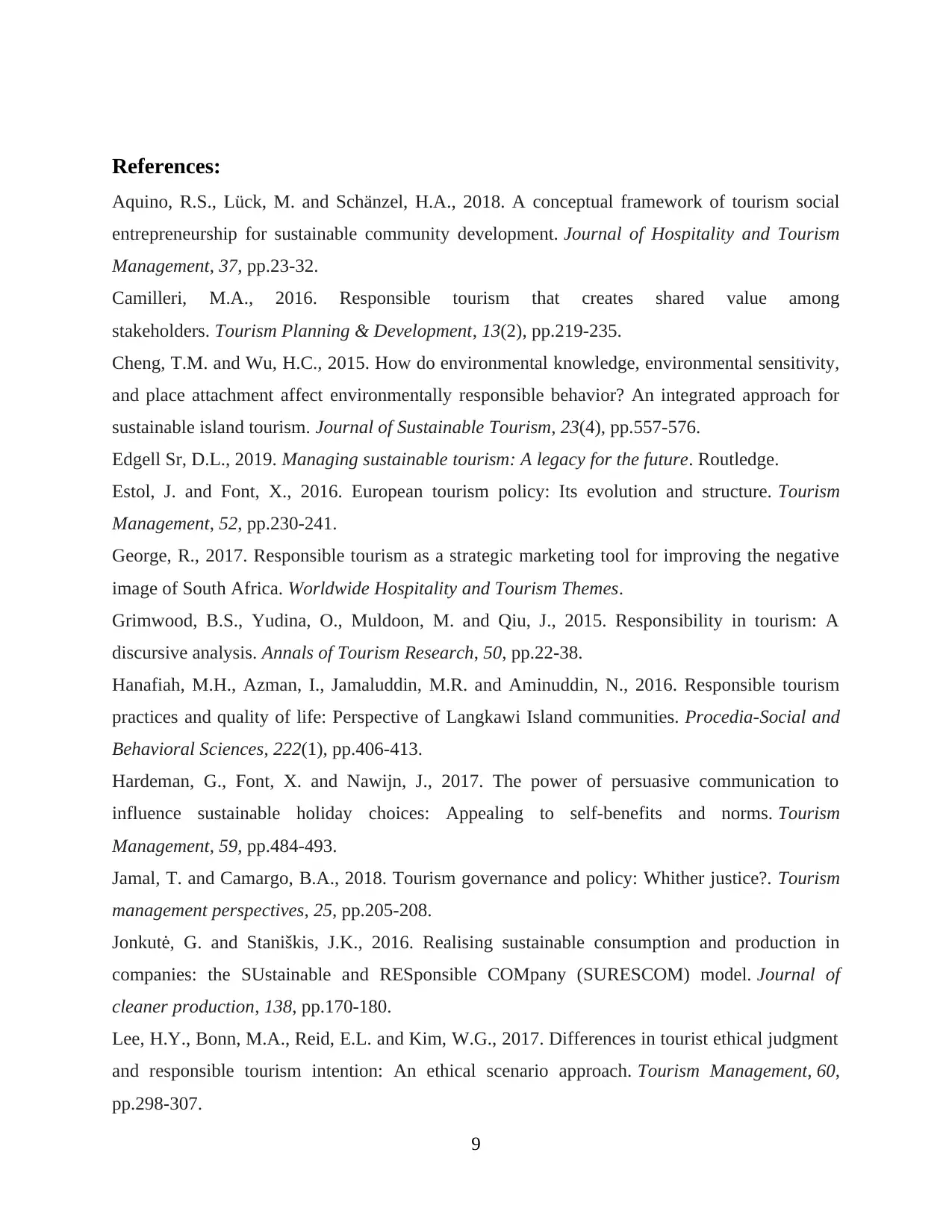
References:
Aquino, R.S., Lück, M. and Schänzel, H.A., 2018. A conceptual framework of tourism social
entrepreneurship for sustainable community development. Journal of Hospitality and Tourism
Management, 37, pp.23-32.
Camilleri, M.A., 2016. Responsible tourism that creates shared value among
stakeholders. Tourism Planning & Development, 13(2), pp.219-235.
Cheng, T.M. and Wu, H.C., 2015. How do environmental knowledge, environmental sensitivity,
and place attachment affect environmentally responsible behavior? An integrated approach for
sustainable island tourism. Journal of Sustainable Tourism, 23(4), pp.557-576.
Edgell Sr, D.L., 2019. Managing sustainable tourism: A legacy for the future. Routledge.
Estol, J. and Font, X., 2016. European tourism policy: Its evolution and structure. Tourism
Management, 52, pp.230-241.
George, R., 2017. Responsible tourism as a strategic marketing tool for improving the negative
image of South Africa. Worldwide Hospitality and Tourism Themes.
Grimwood, B.S., Yudina, O., Muldoon, M. and Qiu, J., 2015. Responsibility in tourism: A
discursive analysis. Annals of Tourism Research, 50, pp.22-38.
Hanafiah, M.H., Azman, I., Jamaluddin, M.R. and Aminuddin, N., 2016. Responsible tourism
practices and quality of life: Perspective of Langkawi Island communities. Procedia-Social and
Behavioral Sciences, 222(1), pp.406-413.
Hardeman, G., Font, X. and Nawijn, J., 2017. The power of persuasive communication to
influence sustainable holiday choices: Appealing to self-benefits and norms. Tourism
Management, 59, pp.484-493.
Jamal, T. and Camargo, B.A., 2018. Tourism governance and policy: Whither justice?. Tourism
management perspectives, 25, pp.205-208.
Jonkutė, G. and Staniškis, J.K., 2016. Realising sustainable consumption and production in
companies: the SUstainable and RESponsible COMpany (SURESCOM) model. Journal of
cleaner production, 138, pp.170-180.
Lee, H.Y., Bonn, M.A., Reid, E.L. and Kim, W.G., 2017. Differences in tourist ethical judgment
and responsible tourism intention: An ethical scenario approach. Tourism Management, 60,
pp.298-307.
9
Aquino, R.S., Lück, M. and Schänzel, H.A., 2018. A conceptual framework of tourism social
entrepreneurship for sustainable community development. Journal of Hospitality and Tourism
Management, 37, pp.23-32.
Camilleri, M.A., 2016. Responsible tourism that creates shared value among
stakeholders. Tourism Planning & Development, 13(2), pp.219-235.
Cheng, T.M. and Wu, H.C., 2015. How do environmental knowledge, environmental sensitivity,
and place attachment affect environmentally responsible behavior? An integrated approach for
sustainable island tourism. Journal of Sustainable Tourism, 23(4), pp.557-576.
Edgell Sr, D.L., 2019. Managing sustainable tourism: A legacy for the future. Routledge.
Estol, J. and Font, X., 2016. European tourism policy: Its evolution and structure. Tourism
Management, 52, pp.230-241.
George, R., 2017. Responsible tourism as a strategic marketing tool for improving the negative
image of South Africa. Worldwide Hospitality and Tourism Themes.
Grimwood, B.S., Yudina, O., Muldoon, M. and Qiu, J., 2015. Responsibility in tourism: A
discursive analysis. Annals of Tourism Research, 50, pp.22-38.
Hanafiah, M.H., Azman, I., Jamaluddin, M.R. and Aminuddin, N., 2016. Responsible tourism
practices and quality of life: Perspective of Langkawi Island communities. Procedia-Social and
Behavioral Sciences, 222(1), pp.406-413.
Hardeman, G., Font, X. and Nawijn, J., 2017. The power of persuasive communication to
influence sustainable holiday choices: Appealing to self-benefits and norms. Tourism
Management, 59, pp.484-493.
Jamal, T. and Camargo, B.A., 2018. Tourism governance and policy: Whither justice?. Tourism
management perspectives, 25, pp.205-208.
Jonkutė, G. and Staniškis, J.K., 2016. Realising sustainable consumption and production in
companies: the SUstainable and RESponsible COMpany (SURESCOM) model. Journal of
cleaner production, 138, pp.170-180.
Lee, H.Y., Bonn, M.A., Reid, E.L. and Kim, W.G., 2017. Differences in tourist ethical judgment
and responsible tourism intention: An ethical scenario approach. Tourism Management, 60,
pp.298-307.
9
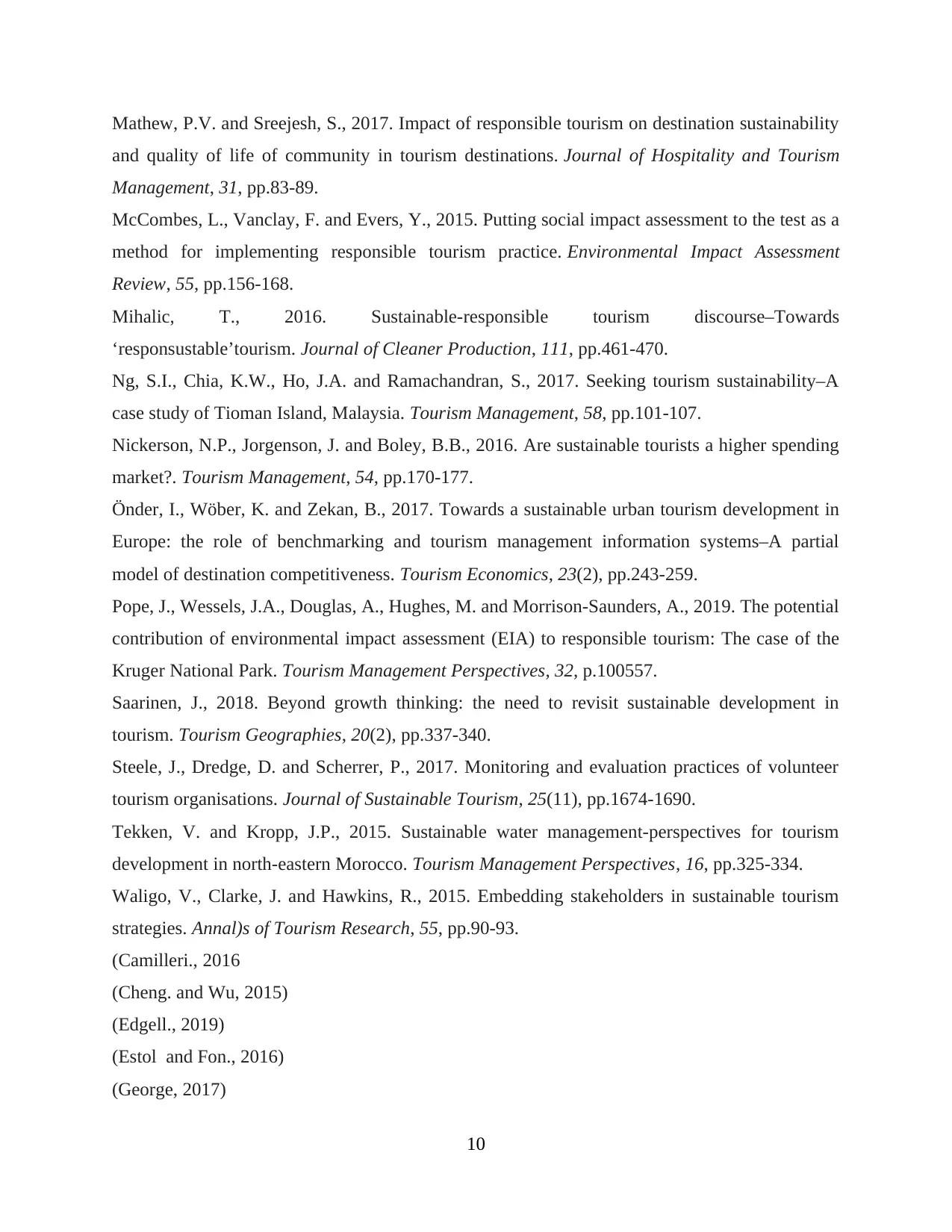
Mathew, P.V. and Sreejesh, S., 2017. Impact of responsible tourism on destination sustainability
and quality of life of community in tourism destinations. Journal of Hospitality and Tourism
Management, 31, pp.83-89.
McCombes, L., Vanclay, F. and Evers, Y., 2015. Putting social impact assessment to the test as a
method for implementing responsible tourism practice. Environmental Impact Assessment
Review, 55, pp.156-168.
Mihalic, T., 2016. Sustainable-responsible tourism discourse–Towards
‘responsustable’tourism. Journal of Cleaner Production, 111, pp.461-470.
Ng, S.I., Chia, K.W., Ho, J.A. and Ramachandran, S., 2017. Seeking tourism sustainability–A
case study of Tioman Island, Malaysia. Tourism Management, 58, pp.101-107.
Nickerson, N.P., Jorgenson, J. and Boley, B.B., 2016. Are sustainable tourists a higher spending
market?. Tourism Management, 54, pp.170-177.
Önder, I., Wöber, K. and Zekan, B., 2017. Towards a sustainable urban tourism development in
Europe: the role of benchmarking and tourism management information systems–A partial
model of destination competitiveness. Tourism Economics, 23(2), pp.243-259.
Pope, J., Wessels, J.A., Douglas, A., Hughes, M. and Morrison-Saunders, A., 2019. The potential
contribution of environmental impact assessment (EIA) to responsible tourism: The case of the
Kruger National Park. Tourism Management Perspectives, 32, p.100557.
Saarinen, J., 2018. Beyond growth thinking: the need to revisit sustainable development in
tourism. Tourism Geographies, 20(2), pp.337-340.
Steele, J., Dredge, D. and Scherrer, P., 2017. Monitoring and evaluation practices of volunteer
tourism organisations. Journal of Sustainable Tourism, 25(11), pp.1674-1690.
Tekken, V. and Kropp, J.P., 2015. Sustainable water management-perspectives for tourism
development in north-eastern Morocco. Tourism Management Perspectives, 16, pp.325-334.
Waligo, V., Clarke, J. and Hawkins, R., 2015. Embedding stakeholders in sustainable tourism
strategies. Annal)s of Tourism Research, 55, pp.90-93.
(Camilleri., 2016
(Cheng. and Wu, 2015)
(Edgell., 2019)
(Estol and Fon., 2016)
(George, 2017)
10
and quality of life of community in tourism destinations. Journal of Hospitality and Tourism
Management, 31, pp.83-89.
McCombes, L., Vanclay, F. and Evers, Y., 2015. Putting social impact assessment to the test as a
method for implementing responsible tourism practice. Environmental Impact Assessment
Review, 55, pp.156-168.
Mihalic, T., 2016. Sustainable-responsible tourism discourse–Towards
‘responsustable’tourism. Journal of Cleaner Production, 111, pp.461-470.
Ng, S.I., Chia, K.W., Ho, J.A. and Ramachandran, S., 2017. Seeking tourism sustainability–A
case study of Tioman Island, Malaysia. Tourism Management, 58, pp.101-107.
Nickerson, N.P., Jorgenson, J. and Boley, B.B., 2016. Are sustainable tourists a higher spending
market?. Tourism Management, 54, pp.170-177.
Önder, I., Wöber, K. and Zekan, B., 2017. Towards a sustainable urban tourism development in
Europe: the role of benchmarking and tourism management information systems–A partial
model of destination competitiveness. Tourism Economics, 23(2), pp.243-259.
Pope, J., Wessels, J.A., Douglas, A., Hughes, M. and Morrison-Saunders, A., 2019. The potential
contribution of environmental impact assessment (EIA) to responsible tourism: The case of the
Kruger National Park. Tourism Management Perspectives, 32, p.100557.
Saarinen, J., 2018. Beyond growth thinking: the need to revisit sustainable development in
tourism. Tourism Geographies, 20(2), pp.337-340.
Steele, J., Dredge, D. and Scherrer, P., 2017. Monitoring and evaluation practices of volunteer
tourism organisations. Journal of Sustainable Tourism, 25(11), pp.1674-1690.
Tekken, V. and Kropp, J.P., 2015. Sustainable water management-perspectives for tourism
development in north-eastern Morocco. Tourism Management Perspectives, 16, pp.325-334.
Waligo, V., Clarke, J. and Hawkins, R., 2015. Embedding stakeholders in sustainable tourism
strategies. Annal)s of Tourism Research, 55, pp.90-93.
(Camilleri., 2016
(Cheng. and Wu, 2015)
(Edgell., 2019)
(Estol and Fon., 2016)
(George, 2017)
10
⊘ This is a preview!⊘
Do you want full access?
Subscribe today to unlock all pages.

Trusted by 1+ million students worldwide
1 out of 13
Related Documents
Your All-in-One AI-Powered Toolkit for Academic Success.
+13062052269
info@desklib.com
Available 24*7 on WhatsApp / Email
![[object Object]](/_next/static/media/star-bottom.7253800d.svg)
Unlock your academic potential
Copyright © 2020–2025 A2Z Services. All Rights Reserved. Developed and managed by ZUCOL.




![Sustainable and Responsible Tourism Management Report - [Course Name]](/_next/image/?url=https%3A%2F%2Fdesklib.com%2Fmedia%2Fimages%2Ftt%2F97543c1e789843e897460d59424ee454.jpg&w=256&q=75)